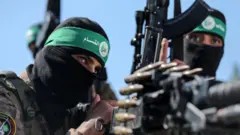The Israel-Gaza conflict is a complex and recurring issue with a long history. The recent escalation of violence has left many wondering, “Why Did Israel Bomb Gaza?” This article delves into the underlying causes, historical context, and the events that led to the latest round of hostilities.
A poignant image capturing the emotional toll of the conflict on civilians in Gaza.
Hamas’s October 2023 Attack: The Catalyst for War
On October 7, 2023, Hamas, the Palestinian militant group controlling the Gaza Strip, launched a surprise attack against Israel. This unprecedented assault involved gunmen targeting Israeli border communities, killing approximately 1,200 people and taking over 250 hostages. The attack also included a significant barrage of rockets fired into Israeli territory.
Hamas fighters pictured during a previous conflict. The group’s October 2023 attack on Israel was a significant escalation in violence.
Israel’s Response: Operation Against Hamas in Gaza
Following the Hamas attack, Israel launched a large-scale military offensive in Gaza. This operation, characterized by intense air strikes and a ground invasion, was aimed at crippling Hamas’s military capabilities, retrieving hostages, and preventing future attacks. The Israeli government declared its intention to dismantle Hamas’s infrastructure and ensure the long-term security of its citizens.
Root Causes of the Conflict: Decades of Tension
While the Hamas attack was the immediate trigger, the roots of the conflict run much deeper. Decades of Israeli-Palestinian tension, fueled by disputes over land, security, and recognition, have created a cycle of violence. Key issues include:
- The Status of Jerusalem: Both Israelis and Palestinians claim Jerusalem as their capital, making it a central point of contention.
- Israeli Settlements: The presence of Israeli settlements in the West Bank and East Jerusalem is a major source of friction.
- The Blockade of Gaza: Israel’s blockade of Gaza, implemented after Hamas took control in 2007, has severely restricted the movement of people and goods, contributing to humanitarian crisis.
- Mutual Distrust and Lack of Recognition: A fundamental lack of trust and recognition between both sides hinders any meaningful progress toward a lasting peace.
Hamas’s Stated Motivations
Hamas claims its attack was a response to what it perceives as decades of Israeli oppression, the ongoing blockade of Gaza, and the killing of Palestinians. The group also cites Israeli actions at the al-Aqsa Mosque compound in Jerusalem, a holy site for both Muslims and Jews, as a contributing factor.
Former Hamas leaders Ismail Haniyeh (left) and Yahya Sinwar (right). Both were killed in separate incidents following the October 2023 attack.
International Involvement and Ceasefire Efforts
The international community has been deeply involved in attempting to mediate ceasefires and find a resolution to the conflict. Several countries and organizations have condemned the violence and called for restraint from both sides. The United Nations has played a significant role in providing humanitarian aid to Gaza and documenting human rights violations. A ceasefire agreement reached in January 2025 aims to halt the fighting, facilitate humanitarian aid, and secure the release of hostages and prisoners.
A Complex and Ongoing Conflict
The question of why Israel bombed Gaza is multifaceted and cannot be answered with a single explanation. The October 2023 Hamas attack was the immediate trigger, but the conflict is rooted in decades of complex historical, political, and religious disputes. Finding a lasting solution will require addressing the underlying causes of the conflict and fostering greater understanding and cooperation between Israelis and Palestinians.
A map illustrating the geopolitical context of the Israel-Gaza conflict. Gaza is a small territory bordered by Israel, Egypt, and the Mediterranean Sea.
The humanitarian crisis in Gaza: A young boy and his infant brother seeking shelter in a tent in Rafah. The conflict has displaced countless families and created dire living conditions.
